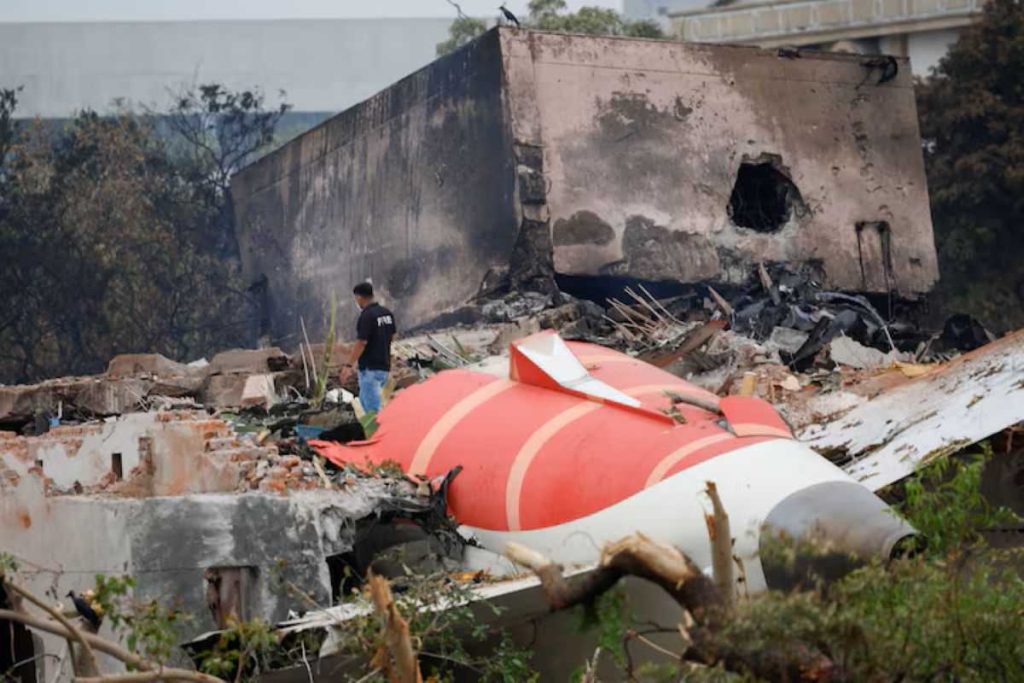June 12, 2025 (Ahmedabad) – A routine London‑bound flight from Ahmedabad ended in tragedy when Air India Flight AI 171, a Boeing 787‑8 Dreamliner, catastrophically crashed into a hostel block moments after takeoff. With 242 people aboard, the death toll soared to 241 onboard, along with at least 28 lives lost on the ground, making it among India’s worst disasters. Authorities, aviation experts, and grieving families now await answers as investigations widen in scope and scale.
Flight AI 171: Takeoff Turned Nightmare
Operating under tail number VT‑ANB, AI 171 departed Sardar Vallabhbhai Patel International Airport at 13:38 IST bound for London Gatwick. Passengers included 169 Indian nationals, 53 British citizens, seven Portuguese, and one Canadian
Within 30 seconds, the jet struggled to climb past approximately 625 ft (190 m), tipped forward, and plunged east of the runway into Meghani Nagar, colliding with the hostel at B. J. Medical College. CCTV footage captured the plane tilting, trailing smoke before exploding in a massive fireball
In a desperate final moment, pilot Captain Sumeet Sabharwal (8,200 flight hours) and First Officer Clive Kundar (1,100 hours) issued a rapid “Mayday” call, losing contact before rescue teams could respond
Read Also: Ahmedabad After Takeoff, Killing Nearly 300: Latest Updates
Scale of the Catastrophe
- 241 onboard were killed, leaving only one survivor, a British‑Indian passenger
- 28‑plus casualties occurred on the ground—students, medical staff, nearby residents—bringing total fatalities to at least 269
- Among the victims was former Gujarat Chief Minister Vijay Rupani, confirmed deceased at the crash site
- Rescue and relief operations involved Indian Army personnel, CRPF, NDRF, and urban search teams. DNA sampling stations were set up due to severe burns rendering visual identification impossible .
Individual Stories: Lives Wiped Out
The crash abruptly ended countless dreams:
- A newlywed couple, captured in a final wedding selfie, boarded the flight together.
- A doctor and his wife, along with their two young daughters, are missing.
- Several international students headed to UK universities, their aspirations extinguished mid‑air.
- Entire families from Gujarat and Maharashtra, flee across borders, wiped from future decades.
Local nurses recounted harrowing scenes of charred bodies and scorched structures, while hospitals around Ahmedabad remain overwhelmed .
Read Also: Tragedy in Ahmedabad: Air India London Flight Crashes After Takeoff, Killing Over 290
he Sole Survivor: Seat 11A’s Lucky Man
The only survivor is Vishwash Kumar Ramesh, a 40‑year‑old British national of Indian descent, who was seated in 11A—an exit‑row seat believed to have spared him from the devastation en.wikipedia.org+6en.wikipedia.org+6zh.wikipedia.org+6.
In hospital, Ramesh recounted, “When I got up, there were bodies all around me. I was scared. I stood up and ran.” He was treated for non‑life‑threatening chest, eye, and foot injuries, and is now listed as stable.
Tragically, his brother Ajay, traveling alongside him, was not so fortunate and remains among the deceased .
Source: Aisanet News English
Investigating the Crash: What Went Wrong?
Aircraft & Conditions
- This marks the first fatal crash of the Boeing 787 series globally since its 2011 debut
- Video analysis suggests extended landing gear, mispositioned flaps, and difficulty gaining lift—likely due to hot air density, a crowded plane, and full fuel tanks
Investigation Teams
- Led by India’s DGCA, teams include Air India, Tata Group, Boeing, GE Aerospace, and international agencies such as the FAA and NTSB
- The Flight Data Recorder and Cockpit Voice Recorder (“black boxes”) have been recovered
- Experts are exploring a range of theories—engine failure, incorrect flap settings, bird strikes, or pilot disorientation caused by high daytime temperatures .
International Response
- Prime Minister Narendra Modi labeled the incident as “heartbreaking beyond words.” UK PM Keir Starmer described it as “devastating for London‑bound families”
- The British government activated crisis response teams in Delhi and London to support victims’ families
- Tata Group pledged ₹10 million (~£86,000) in compensation per fatality and assistance with medical costs, rebuilding efforts, and repatriation
- The FAA and NTSB are offering technical assistance beyond standard oversight .
Economic & Aviation Industry Impact
- Shares of Boeing dropped sharply post‑crash; the 787 had held a clean safety record since entering service .
- Premium insurance and compensation payouts are expected to be among the largest in Indian civil aviation history.
- Regulatory bodies may impose flight restrictions or grounding orders pending initial findings—mirroring past responses seen with Boeing 737 Max incidents.
What Happens Next?
- A preliminary investigation report is expected within 30 days, focusing on immediate cause factors.
- Full technical analysis of black box data, maintenance records, and crew training logs will continue over several months.
- DGCA may update Indian aviation rules on flap procedures, temperature‑based takeoff protocols, and mandatory emergency‑row seating review.
- Victim identification via forensic teams and DNA labs will continue across Gujarat hospitals.
- International regulators may request additional safety audits for Boeing 787s and other wide‑body fleets.
Read Also: Latest updates Air India Plane Crash Near Ahmedabad Airport
Final Thoughts
This tragedy is a stark reminder of aviation’s inherent risks—even in highly regulated, modern fleets. As the global community awaits the black‑box findings, families seek closure and the world honors the memory of those lost. The saga of AI 171 will not be measured in pages of reports alone—but by the lasting changes it forces upon aviation, regulations, and grief-stricken communities alike.
